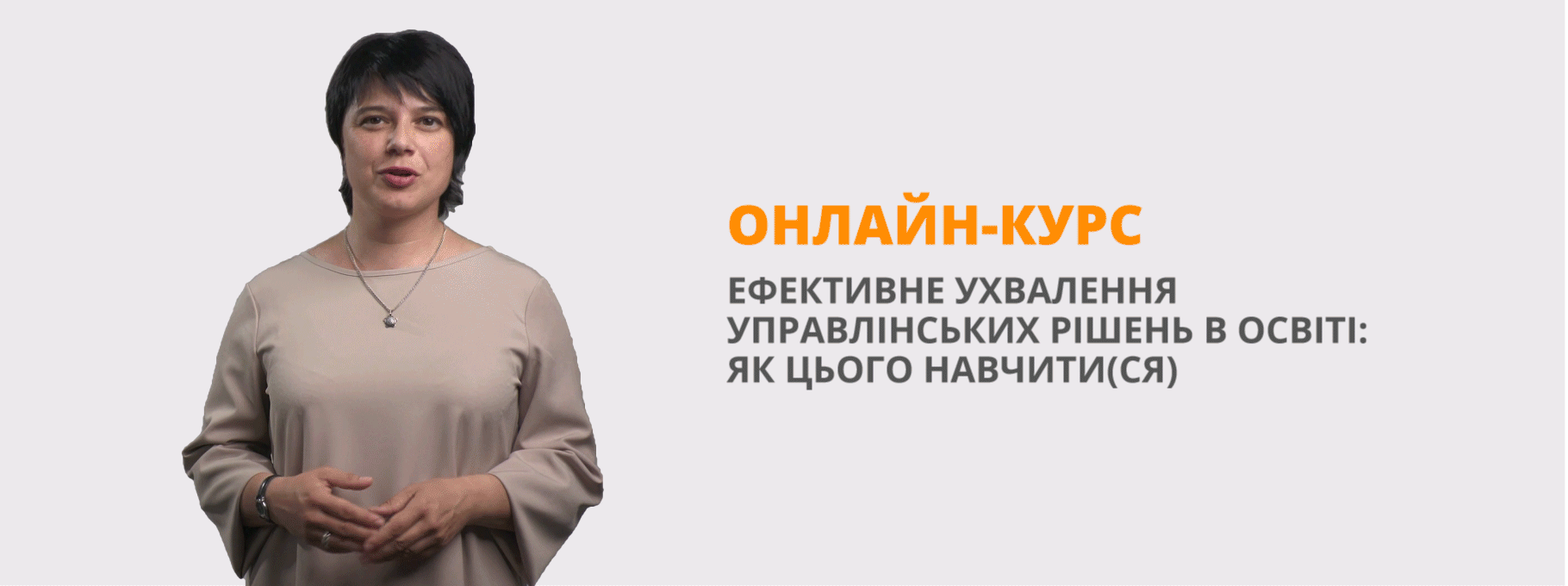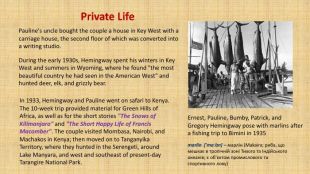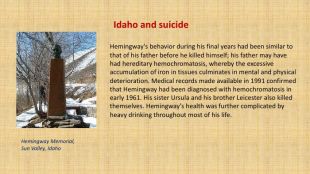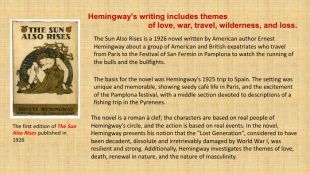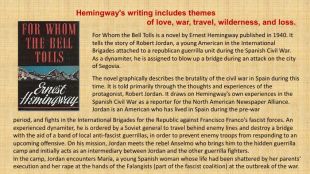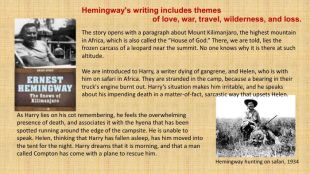Ернест Гемінґвей. Життя і творчість (презентація)








![Ernest, Pauline, Bumby, Patrick, and Gregory Hemingway pose with marlins after a fishing trip to Bimini in 1935marlin ['mɑːlɪn] – марлін (Makaira; риба, що мешкає в тропічній зоні Тихого та Індійського океанів; є об'єктом промислового та спортивного лову)During the early 1930s, Hemingway spent his winters in Key West and summers in Wyoming, where he found Ernest, Pauline, Bumby, Patrick, and Gregory Hemingway pose with marlins after a fishing trip to Bimini in 1935marlin ['mɑːlɪn] – марлін (Makaira; риба, що мешкає в тропічній зоні Тихого та Індійського океанів; є об'єктом промислового та спортивного лову)During the early 1930s, Hemingway spent his winters in Key West and summers in Wyoming, where he found](/uploads/files/2059233/334509/375727_images/9.jpg)












An American novelist, short-story writer, and journalist. Many of his works are considered classics of American literature. July 21, 1899 – July 2, 1961 Ernest Miller Hemingway Hemingway was awarded the 1954 Nobel Prize in Literature. He published seven novels, six short-story collections, and two nonfiction works. Three of his novels, four short-story collections, and three nonfiction works were published posthumously. His economical and understated style—which included his iceberg theory —had a strong influence on 20th-century fiction, while his adventurous lifestyle and public image brought him admiration from later generations. According to his iceberg theory the writer can omit much of what he knows, but the reader will still feel the omission as much as if the writer had said it.
Hemingway was the second child and first son born to Clarence and Grace. Ernest Miller Hemingway was born on July 21, 1899, in Oak Park, Illinois, an affluent suburb just west of Chicago, to Clarence Edmonds Hemingway, a physician, and Grace Hall Hemingway, a musician. His parents were well-educated and well-respected in Oak Park. Early life. Hemingway's mother, a well-known musician in the village, taught her son to play the cello despite his refusal to learn. Each summer the family traveled to Windemere on Walloon Lake, near Petoskey, Michigan. There young Ernest joined his father and learned to hunt, fish, and camp in the woods and lakes of Northern Michigan, early experiences that instilled a life-long passion for outdoor adventure and living in remote or isolated areas. The Hemingway family in 1905 (from the left): Marcelline, Sunny, Clarence, Grace, Ursula, and Ernest
Hemingway attended Oak Park and River Forest High School in Oak Park from 1913 until 1917. He was a good athlete, involved with a number of sports—boxing, track and field, water polo, and football; performed in the school orchestra for two years with his sister Marcelline; and received good grades in English classes. In 1918, he was seriously wounded and returned home. His wartime experiences formed the basis for his novel A Farewell to Arms (1929). In December 1917, after being rejected by the U. S. Army for poor eyesight. Hemingway responded to a Red Cross recruitment effort and signed on to be an ambulance driver in Italy. World War IAfter high school, he was a reporter for a few months for The Kansas City Star.
Hemingway returned home early in 1919 to a time of readjustment. Before the age of 20, he had gained from the war a maturity that was at odds with living at home without a job and with the need for recuperation. Toronto and Chicago. In September, he took a fishing and camping trip with high-school friends to the back-country of Michigan's Upper Peninsula. The trip became the inspiration for his short story "Big Two-Hearted River", in which the semi-autobiographical character Nick Adams takes to the country to find solitude after returning from war. A family friend offered him a job in Toronto, and with nothing else to do, he accepted. Late that year he began as a freelancer and staff writer for the Toronto Star Weekly. He returned to Michigan and then moved to Chicago in September 1920 to live with friends, while still filing stories for the Toronto Star.
Martha Gellhorn became his third wife in 1940. He and Gellhorn separated after he met Mary Welsh in London during World War II. Hemingway was present with Allied troops as a journalist at the Normandy landings and the liberation of Paris. Private Life. In 1921, he married Hadley Richardson, the first of four wives. They moved to Paris, where he worked as a foreign correspondent for the Toronto Star and fell under the influence of the modernist writers and artists of the 1920s' "Lost Generation" expatriate community. Hemingway's debut novel The Sun Also Rises was published in 1926. He divorced Richardson in 1927, In 1927 he married Pauline Pfeiffer. They divorced after he returned from the Spanish Civil War (1936–1939), which he covered as a journalist and which was the basis for his novel For Whom the Bell Tolls (1940). Gellhorn inspired him to write his most famous novel, For Whom the Bell Tolls, which he began in March 1939 and finished in July 1940. It was published in October 1940.
Ernest, Pauline, Bumby, Patrick, and Gregory Hemingway pose with marlins after a fishing trip to Bimini in 1935marlin ['mɑːlɪn] – марлін (Makaira; риба, що мешкає в тропічній зоні Тихого та Індійського океанів; є об'єктом промислового та спортивного лову)During the early 1930s, Hemingway spent his winters in Key West and summers in Wyoming, where he found "the most beautiful country he had seen in the American West" and hunted deer, elk, and grizzly bear. Pauline's uncle bought the couple a house in Key West with a carriage house, the second floor of which was converted into a writing studio. In 1933, Hemingway and Pauline went on safari to Kenya. The 10-week trip provided material for Green Hills of Africa, as well as for the short stories "The Snows of Kilimanjaro" and "The Short Happy Life of Francis Macomber". The couple visited Mombasa, Nairobi, and Machakos in Kenya; then moved on to Tanganyika Territory, where they hunted in the Serengeti, around Lake Manyara, and west and southeast of present-day Tarangire National Park.
In 1937, Hemingway left for Spain to cover the Spanish Civil War for the North American Newspaper Alliance. Spanish Civil War. Ernest Hemingway (centre) while reporting on the Spanish Civil War for the North American Newspaper Alliance in 1937. Late in 1937, while in Madrid with Martha, Hemingway wrote his only play, The Fifth Column, as the city was being bombarded by Francoist forces. He returned to Key West for a few months, then back to Spain twice in 1938, where he was present at the Battle of the Ebro, the last republican stand, and he was among the British and American journalists who were some of the last to leave the battle as they crossed the river.
Hemingway was in Europe from May 1944 to March 1945. When he arrived in London, he met Time magazine correspondent Mary Welsh, who later became his fourth wife. World War IIIn 1947, Hemingway was awarded a Bronze Star for his bravery during World War II. He was recognized for having been "under fire in combat areas in order to obtain an accurate picture of conditions", with the commendation that "through his talent of expression, Mr. Hemingway enabled readers to obtain a vivid picture of the difficulties and triumphs of the front-line soldier and his organization in combat"Hemingway with Col. Charles "Buck" Lanham in Germany, 1944, during the fighting in Hürtgenwald, after which he became ill with pneumonia. On August 25, he was present at the liberation of Paris as a journalist. Later that year, he observed heavy fighting in the Battle of Hürtgen Forest. On December 17, 1944, he had himself driven to Luxembourg in spite of illness to cover The Battle of the Bulge. As soon as he arrived, however, Lanham handed him to the doctors, who hospitalized him with pneumonia.
Hemingway said he "was out of business as a writer" from 1942 to 1945 during his residence in Cuba. In 1946 he married Mary. Cuba and the Nobel Prize. The Hemingway family suffered a series of accidents and health problems in the years following the war. A 1947 car accident left his son Patrick with a head wound and severely ill. In a 1945 car accident, he "smashed his knee" and sustained another "deep wound on his forehead"; Mary broke first her right ankle and then her left in successive skiing accidents. Hemingway sank into depression as his literary friends began to die: in 1939 William Butler Yeats and Ford Madox Ford; in 1940 F. Scott Fitzgerald; in 1941 Sherwood Anderson and James Joyce; in 1946 Gertrude Stein; and the following year in 1947, Max Perkins, Hemingway's long-time Scribner's editor, and friend. During this period, he suffered from severe headaches, high blood pressure, weight problems, and eventually diabetes—much of which was the result of previous accidents and many years of heavy drinking. Hemingway in the cabin of his boat Pilar, off the coast of Cuba, c. 1950
In October 1954, Hemingway received the Nobel Prize in Literature. He modestly told the press that Carl Sandburg, Isak Dinesen and Bernard Berenson deserved the prize, but he gladly accepted the prize money. Mellow says Hemingway "had coveted the Nobel Prize", but when he won it, months after his plane accidents and the ensuing worldwide press coverage, "there must have been a lingering suspicion in Hemingway's mind that his obituary notices had played a part in the academy's decision." Because he was suffering pain from the African accidents, he decided against traveling to Stockholm. Instead he sent a speech to be read, defining the writer's life. In this brilliant, elegantly written biography, award-winning author James R. Mellow offers a thorough reassessment of a man who was both a literary giant and an icon for his age.
Idaho and suicide. Hemingway's behavior during his final years had been similar to that of his father before he killed himself; his father may have had hereditary hemochromatosis, whereby the excessive accumulation of iron in tissues culminates in mental and physical deterioration. Medical records made available in 1991 confirmed that Hemingway had been diagnosed with hemochromatosis in early 1961. His sister Ursula and his brother Leicester also killed themselves. Hemingway's health was further complicated by heavy drinking throughout most of his life. Hemingway Memorial, Sun Valley, Idaho
The first edition of The Sun Also Rises published in 1926 The Sun Also Rises is a 1926 novel written by American author Ernest Hemingway about a group of American and British expatriates who travel from Paris to the Festival of San Fermín in Pamplona to watch the running of the bulls and the bullfights. The basis for the novel was Hemingway's 1925 trip to Spain. The setting was unique and memorable, showing seedy café life in Paris, and the excitement of the Pamplona festival, with a middle section devoted to descriptions of a fishing trip in the Pyrenees. The novel is a roman à clef; the characters are based on real people of Hemingway's circle, and the action is based on real events. In the novel, Hemingway presents his notion that the "Lost Generation", considered to have been decadent, dissolute and irretrievably damaged by World War I, was resilient and strong. Additionally, Hemingway investigates the themes of love, death, renewal in nature, and the nature of masculinity. Hemingway's writing includes themes of love, war, travel, wilderness, and loss.
A Farewell to Arms is a novel by Ernest Hemingway set during the Italian campaign of World War I. The book, published in 1929, is a first-person account of American Frederic Henry, serving as a Lieutenant in the ambulance corps of the Italian Army. The title is taken from a poem by 16th-century English dramatist George Peele. A Farewell to Arms is about a love affair between the expatriate American Henry and Catherine Barkley against the backdrop of the First World War, cynical soldiers, fighting and the displacement of populations. The publication of A Farewell to Arms cemented Hemingway's stature as a modern American writer, became his first best-seller, and is described by biographer Michael Reynolds as "the premier American war novel from that debacle World War I.”The novel has been adapted for the stage, initially in 1930 and subsequently, for film in 1932 and 1957, and as a television miniseries in 1966. The 1996 film In Love and War, directed by Richard Attenborough and starring Chris O'Donnell and Sandra Bullock, depicts Hemingway's life in Italy as an ambulance driver in the events prior to his writing of A Farewell to Arms. Hemingway's writing includes themes of love, war, travel, wilderness, and loss.
For Whom the Bell Tolls is a novel by Ernest Hemingway published in 1940. It tells the story of Robert Jordan, a young American in the International Brigades attached to a republican guerrilla unit during the Spanish Civil War. As a dynamiter, he is assigned to blow up a bridge during an attack on the city of Segovia. The novel graphically describes the brutality of the civil war in Spain during this time. It is told primarily through the thoughts and experiences of the protagonist, Robert Jordan. It draws on Hemingway's own experiences in the Spanish Civil War as a reporter for the North American Newspaper Alliance. Jordan is an American who has lived in Spain during the pre-war period, and fights in the International Brigades for the Republic against Francisco Franco's fascist forces. An experienced dynamiter, he is ordered by a Soviet general to travel behind enemy lines and destroy a bridge with the aid of a band of local anti-fascist guerrillas, in order to prevent enemy troops from responding to an upcoming offensive. On his mission, Jordan meets the rebel Anselmo who brings him to the hidden guerrilla camp and initially acts as an intermediary between Jordan and the other guerrilla fighters. In the camp, Jordan encounters María, a young Spanish woman whose life had been shattered by her parents' execution and her rape at the hands of the Falangists (part of the fascist coalition) at the outbreak of the war. Hemingway's writing includes themes of love, war, travel, wilderness, and loss.
The Old Man and the Sea is a short novel written by the American author Ernest Hemingway in 1951 in Bimini, Bahamas, and published in 1952. It was the last major work of fiction by Hemingway that was published during his lifetime. One of his most famous works, it tells the story of Santiago, an aging Cuban fisherman who struggles with a giant marlin far out in the Gulf Stream off the coast of Florida. In 1953, The Old Man and the Sea was awarded the Pulitzer Prize for Fiction, and it was cited by the Nobel Committee as contributing to their awarding of the Nobel Prize in Literature to Hemingway in 1954. A group of fishermen gather the next day around the boat where the fish's skeleton is still attached. One of the fishermen measures it to be 18 feet (5.5 m) from nose to tail. Pedrico is given the head of the fish, and the other fishermen tell Manolin to tell the old man how sorry they are. Tourists at the nearby café mistakenly take it for a shark. The boy, worried about the old man, cries upon finding him safe asleep and at his injured hands. Manolin brings him newspapers and coffee. When the old man wakes, they promise to fish together once again. Hemingway's writing includes themes of love, war, travel, wilderness, and loss.
Hemingway hunting on safari, 1934 The story opens with a paragraph about Mount Kilimanjaro, the highest mountain in Africa, which is also called the “House of God.” There, we are told, lies the frozen carcass of a leopard near the summit. No one knows why it is there at such altitude. We are introduced to Harry, a writer dying of gangrene, and Helen, who is with him on safari in Africa. They are stranded in the camp, because a bearing in their truck's engine burnt out. Harry's situation makes him irritable, and he speaks about his impending death in a matter-of-fact, sarcastic way that upsets Helen. As Harry lies on his cot remembering, he feels the overwhelming presence of death, and associates it with the hyena that has been spotted running around the edge of the campsite. He is unable to speak. Helen, thinking that Harry has fallen asleep, has him moved into the tent for the night. Harry dreams that it is morning, and that a man called Compton has come with a plane to rescue him. Hemingway's writing includes themes of love, war, travel, wilderness, and loss.
What do we know about the childhood of Ernest Hemingway?What activities did he enjoy while studying at school?How did E. Hemingway get to the front of the first world war?How did it happen that he started writing for the Toronto Star Weekly?Did his private life influence his writings?How many times did Hemingway visit Spain in the years of Spanish Civil War?What award did he get in 1947?What was the reason of Hemingway’s depression in the last years of his life?When did Hemingway receive the Nobel Prize in Literature?In which works of Hemingway is the theme of the “lost generation” raised?Lost Generation, a group of American writers who came of age during World War I and established their literary reputations in the 1920s. The words themselves were first attributed to Gertrude Stein by Ernest Hemingway.


про публікацію авторської розробки
Додати розробку
